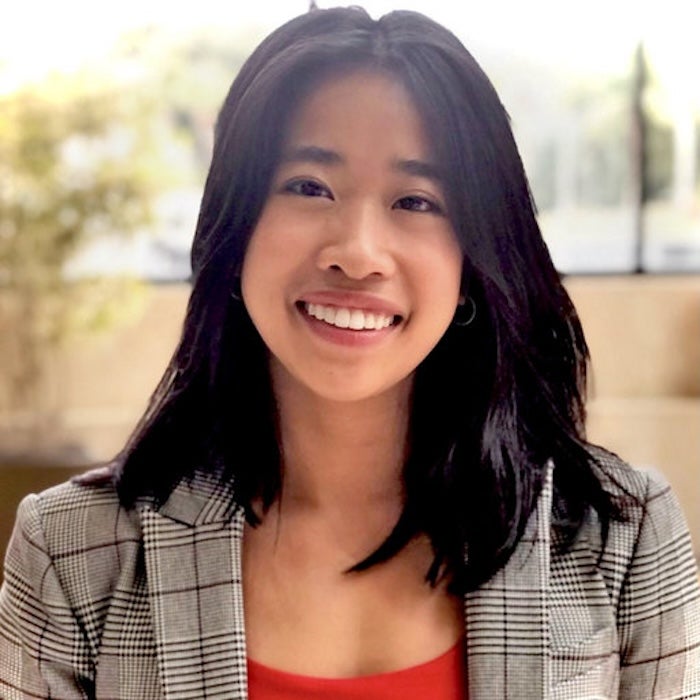Ly wins award to further understanding of atrial fibrillation
block

UIC Medical Scientist Training Program (MSTP) alumna Olivia Ly was recently awarded the Michael and Kate Bárány Research Award, through which she received $1000 for excellence in research to graduating College of Medicine students. Through the MSTP, Ly received both her PhD and MD.
She received this award for her work on human induced pluripotent stem cell-derived cardiomyocytes (IPSC) as a model for heritable arrhythmias to personalize therapies for individual patients.
Through her research, Ly developed a model for understanding the genetics and electrophysiology of atrial fibrillation (A-fib), the most common type of cardiac arrhythmia or irregular heartbeat in clinical practice.
The model was created by generating a repository of atrial tissue with blood cells from patients’ atrial tissue, collected by collaborating surgeons. Ly transformed the peripheral blood mononuclear cells into stem cells and, along with the human atrial tissue, created a mature model that allowed her to study the genetics of A-fib.
After completing a rotation with Professor of Medicine and Pharmacology Dawood Darbar, Ly joined his lab because of his record of translational research and his outstanding mentorship. Darbar is also the director of the Center for Cardiovascular Research, the chief of the Division of Cardiology at UI Health, and the co-director of the MSTP.
Through her involvement in Darbar’s lab, a collaboration with Richard and Loan Hill Department of Biomedical Engineering Professor Salman Khetani emerged.
Creating a mature iPSC-derived cardiomyocyte model allowed Ly to study the two mutations to better understand how cardiac arrhythmia develops and why it develops in certain people and not others. Ly noted that if researchers understand why it happens, they can understand how to treat it.
“The point of this was targeted pharmacologic therapy for patients with A-fib. There were also a lot of concurrent projects, including a crossover study focusing on managing patients with A-fib and how different types of drugs can treat different patients with different genetic variants,” she said.
Ly, Darbar, and their team’s research was published in 2021 in the Journal for Clinical Investigation Insight.
“We have a model to further study the management of A-fib, and hopefully, the publication will set the groundwork for other people to expand upon that, create more improved models, and create more comprehensive targets for a better understanding of the disease,” Ly said.
Since graduating, her lab colleagues have continued to use the model she created. More specifically, Arvind Sridhar of Darbar’s lab is using Ly’s model to look at the interactions between obesity and A-fib.
In addition, Ly and her group have a concurrent study with Ankur Saxena, formerly of UIC, now an associate professor at the University of Alabama-Birmingham Heersink School of Medicine, that uses Zebrafish to better understand the mechanisms of A-fib using IPSCs. She added that IPSC work should be done alongside an animal model for a better overview of how they interact with different working systems in the body.
Before her time at UIC, Ly graduated with bachelor’s and master’s degrees in biomedical engineering from Cornell University.
“I went into medical school not knowing what I wanted to do, and that feeling persisted when I was starting my PhD while exploring different specialties and areas of research,” Ly said. “I fell in love with the research and the physiology with how the heart is such a self-sustaining system, that is electrically managed, but also mechanically managed. It also drives the rest of the body, and I liked that connection. I also went into the operating room to work with surgeons and see the heart beating, both in A-Fib and normal rhythm, and that connection was something that I kept going back to.”
Since graduating from UIC’s MSTP, Ly is completing her residency at the University of Maryland Medical Center as an integrated cardiothoracic surgery resident. She hopes to continue her physician-scientist pathway as her residency is a 3-2-3 program with three years of clinical work, two years of research, and then three more years of clinical work.
“Research is pervasive throughout this program even though there are two years dedicated to research,” she said. “I love how I can connect the two fields.”